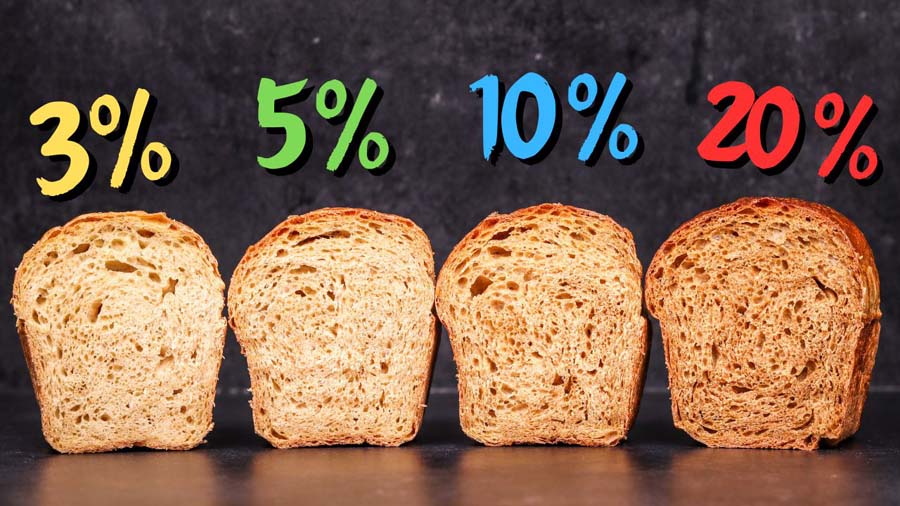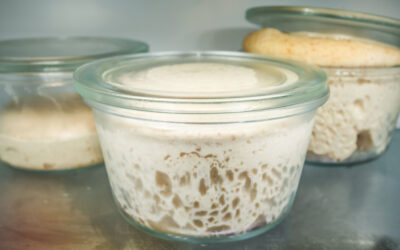Sugar is one of the most used additives in breadmaking and it is also one of the most misunderstood ingredients in breadmaking. I’ve covered the topic of sugar in a couple of dedicated videos already. You can find those in the Principles of Baking playlist along with many more useful and interesting videos.
Sugar comes in many forms – from fully processed granulated white sugar to light brown to dark brown sugar, honey, molasses, treacle, maple syrup, agave syrup, corn syrup, and more. First and foremost, it is sweet, but depending on the type it can also have a distinct flavour from lightly caramelized to bitter and even burnt.
How does sugar affect bread dough.
Sugar affects various bread dough characteristics depending on how much of it is added. It can make the dough sticker and slightly harder to work with. It can weaken the gluten structure which can be beneficial in some cases and detrimental in others. It makes the bread sweeter, the crumb softer, it may add a flavour, and it will improve the colour of the crust. There is one thing it almost never does and that is speed up fermentation. Contrary to popular belief sugar actually slows down fermentation in most cases.
Flour contains enzymes which when water is added break down the starch of the flour and convert it to simple sugars. The enzymes create the food which the yeast then feeds on and uses to multiply, create gas, alcohol, and ferment our bread dough. Yeast does not need any additional sugar. I have never run into a situation where I have needed to add sugar to bread dough (or anything else for that matter) to ‘help’ it ferment.
The sugar which we use in breadmaking is hygroscopic which means that it attracts water. When we add sugar to bread dough it pulls water through the yeast’s cell membrane and dehydrates it which slows down its activity. The same happens when we use salt.
Sugar can help boost fermentation a little bit if added in small amounts of around 3% or less. The reason this works is because unlike with the sugar the enzymes create the sugar which we add is instantly available and the yeast can go for it right away.
Anything above 3% will slow down fermentation. Of course, this should not be an issue. We simply let the dough ferment for longer or use more yeast or make it warmer or place it in a warmer area. There are always options for adjusting the method or formula to account for any changes. I’m not telling you not to use sugar, I’m only telling you to use it for the right reasons.
The recipes.
In the video I made two sets of four breads. The first four were made with white sugar which is probably the most used type of sugar. The second four were made with black treacle. Treacle is a very thick, sweet, dark, and bitter syrup made from cane molasses and invert sugar syrup. It is similar to pure molasses but with a stronger almost burnt flavour. This type of syrup works well with stronger flavoured breads made with whole grains and seeds.
The percentages of sugar/syrup in the two sets of recipes were 3%, 5%, 10%, and 20% in baker’s percentage. Each recipe contained 150g flour, 90g water, 3g salt, 2g instant dry yeast. All were baked for 30 minutes at 170C with the fan on.
Observations.
When mixing I could clearly feel a difference is stickiness as the sugar content increased in both the regular sugar and treacle doughs. The higher the sugar content the looser the dough became. All the doughs were still manageable especially because the hydration of the base recipe was relatively low at just 60%. The wetter the dough the more difficult it would be to work with. Of course, usually sugar is added to lower hydration recipes so it should not cause any issues in that sense.
One characteristic advantage the syrup has over regular sugar is that it is acidic which can actually help with strengthening gluten or at the least not weakening it too much. The syrup containing doughs were easier to handle. Another unique thing about syrup is that it is not 100% sugar as it contains around 20% water which is why it is liquid in the first place.
We could clearly see a difference in fermentation rate as the sugar content increased. With each increase the dough took an extra 15 minutes in final proofing time. It was an extra 45 minutes between the first and last of the white sugar doughs. The first dough took 45 minutes to proof which means that the final one took exactly double that.
The crust of all the breads standing next to each other displayed a nice gradient from light brown to dark brown. And the crumb became softer and more open with the higher sugar content.
Final advice.
Sugar has its place in breadmaking. It can improve the flavour, eating quality, and the look of bread. Use it for the right reasons and be prepared to adjust your recipe to account for all the effects that sugar will have. There is no right or wrong amount of sugar and there is no law for using any type of sugar for any particular bake. Find what works best for you and your recipe.



